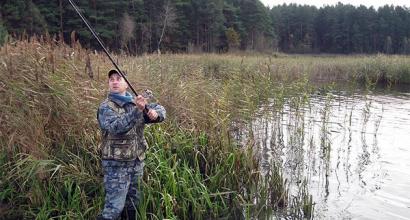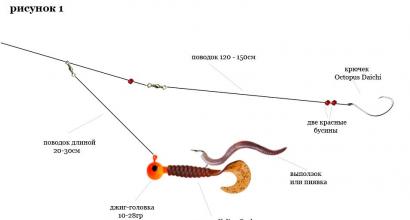Catching pike perch on a jig, how does it work? Lures, rigs and features
Fishing with a jig- a fairly common variation of spinning fishing, in which the bait moves near the bottom. The essence of the method lies in the fact that the bait, as a rule, is a silicone fish, which is loaded in the front part, is carried out in stepped wiring, which creates very attractive movements for predatory fish species.
This is a kind of dance at the bottom, because the wiring received this name for the characteristic “dancing” jerks.
Pike perch most of the time lives and feeds in the lower layers of the water, and therefore targeted hunting for it with the help of this gear is possible.
Tackle selection
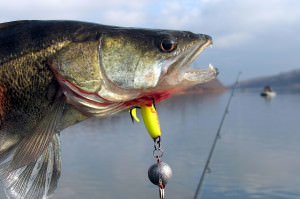
Gear for catching zander on a jig has its own characteristics and depends on the size of the jig head. The mass of the jig bait, in turn, is also different. When fishing in the current, and for fish of trophy sizes, the largest jig is selected, when catching small fish - no more than 3 grams.
When choosing a spinning rod, preference should be given to models that have a small test, but are quite strong and of high quality, able to withstand strong jerks of predatory fish. Many manufacturers of spinning rods have a line of rod models designed for jig fishing.
As a rule, the length of the blank is no more than 2.5 meters, which allows you to conveniently position yourself for jig fishing on the bank of the river, overgrown with trees, or take a spinning rod on board a boat and fish at a considerable depth.
The jig fishing reel is used exclusively inertialess. The size of the reel depends on the weight of the lure and the fishing conditions. The more massive the jig, the larger this tackle should be. But in any case, this part of the spinning should be of high quality, because an unreliable mechanism can fail the fisherman at any time, and leave him without a catch.
When fishing for pike perch on a jig, a braided fishing line is used, which, thanks to its low stretchability, allows you to respond in time to changes in the behavior of the bait and sharply hook the fish at the right time.
Jig heads and lures
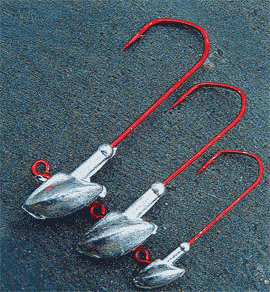
bright jig head Fire
The choice of jig head depends on the conditions of fishing and the bait that is used to attract the predator.
In the case when artificial silicone bait is used, then bright colors should be chosen for catching zander, orange and lemon colors may be of most interest to this fish. The size of the bait, even when hunting for trophy pike perches, should not exceed 12 centimeters. The weight of the bait depends on many factors, but the average weight is in the range of 15 - 18 grams.
rigging
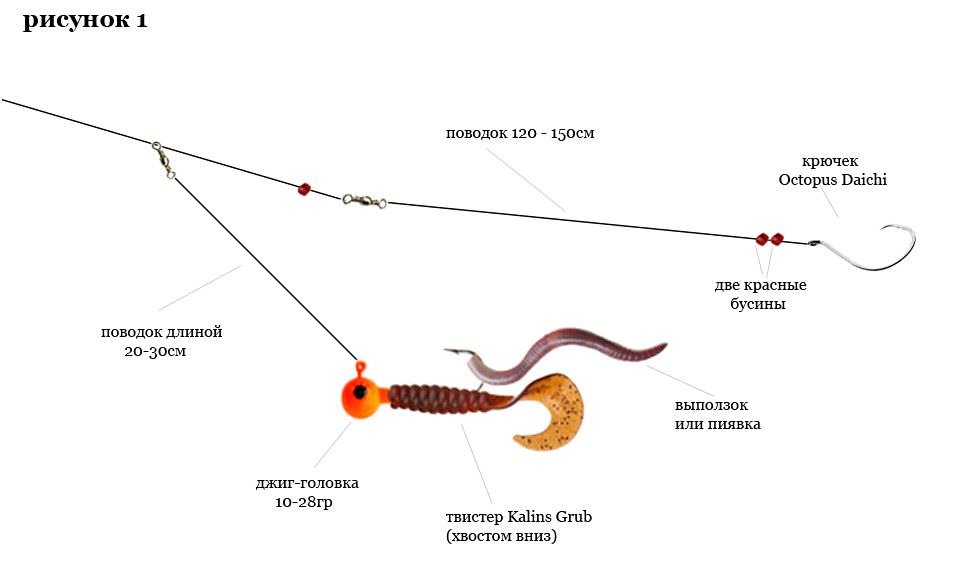
harness with leash
- Direct snap, at which the cord is connected to the jig head, is the most popular. With this option of attaching the gear, the bait is securely attached to the braided fishing line, which allows you to fish very large pike perches along with snags in which they try to hide without breaking the bait. But with a hook that cannot be eliminated, you have to cut a significant amount of the cord, which is not very pleasant to do.
- Snap with leash allows, when a hook is formed, to break off the jig head along with a small piece of monofilament. This design is also not without drawbacks; when catching pike perch, sometimes very toothy individuals come across that can easily grind a monofilament nylon.
jig fishing technique
 Like any other type of fishing, jigging for zander begins with finding a suitable place.
Like any other type of fishing, jigging for zander begins with finding a suitable place.
Pike perch chooses the deepest places in the reservoir, so if it is not possible to determine the bottom relief with the help of an echo sounder, test casts of the sinker are made, followed by pulling up to the shore and the differences in the bottom surface of the reservoir are determined by the changing angle between the line and the rod.
On the river you can find deep places where the width of the channel is much less than upstream and downstream.
The nature of the ripples on the water can also determine the presence of deep places. If, with a slight breeze, the ripples on the reservoir are not formed on the entire surface, then in places where the ripples are completely absent, you should look for a deep place.
The depth of the reservoir is determined visually by the color of the water, the darker, the greater the distance in this place from the surface of the reservoir to its bottom.
The depth of the reservoir in absentia can be determined by the presence of vegetation in the reservoir. Reed grows only in those places where the depth of the reservoir does not exceed 2 meters, water lilies can grow in deep places, but not more than 3 meters below the water surface.
River bends are promising places for jigging zander. In such places, on the bank, which is located on the outer diameter of the rounding of the riverbed, the deepest places are formed.
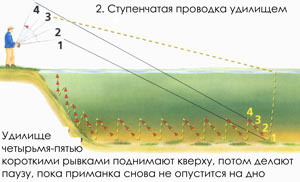
Stepped wiring jig bait is the most popular and is carried out as follows:
- The bait is cast a considerable distance from the shore or boat.
- After the jig head reaches the surface of the water, it is necessary to wait a few seconds until the bait is completely
won't sink to the bottom. - After the jig head is at the bottom, the fisherman makes several turns with the reel, followed by a pause, at which time the bait again reaches the bottom.
- Thus, stepwise wiring is performed before the fish bites, or the bait reaches the shore.
Wiggling wiring is also a fairly catchy technique. Such wiring differs from the stepped one only in that during pauses, when the bait sinks to the bottom, a slight swaying of the tip of the rod is made, which additionally attracts the fish, especially when it is passive.
Tightened wiring- this technique is also not too different from the stepped one. The difference is expressed in the presence of a pause when the bait reaches the bottom. Such stops usually last no more than 3 seconds, but in some situations they play a decisive role in the attraction of a predator.
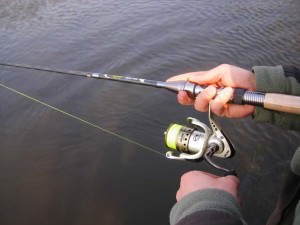
By dragging the bait along the bottom, it is sometimes possible to attract inactive fish. This wiring is carried out by standard casting of the bait and lowering it to the bottom, after which the coil is rotated very slowly so that the bait rises from the bottom of the reservoir.
With the implementation of such tactics of catching fish, the bottom soil is “plowed”, which, rising into the water column, attracts pike perch at a considerable distance. In practice, such wiring is not effective on a rocky bottom, and in those places where algae have grown strongly, which will immediately be captured by the bait.
The equipment of such a bait is carried out only with non-hooking hooks., otherwise you will need to stock up on a large number of spare jig heads.
Features of fishing
Depending on the season
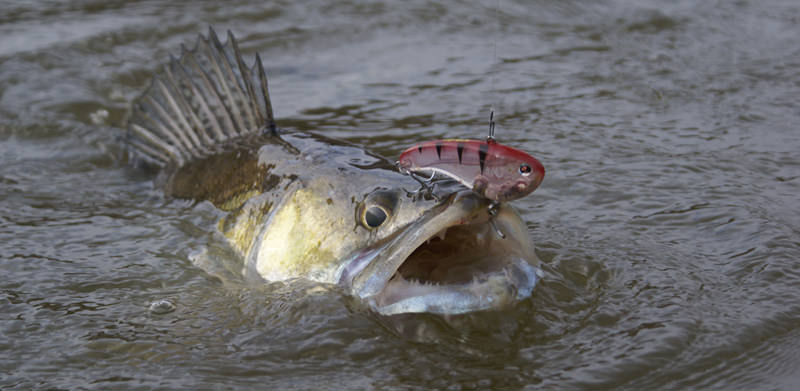
Very good results in summer fishing can be obtained in the early morning, at which time the predator can hunt fry near the shore and rush to the jig when the bait approaches the coastal shallows.
In the spring, when the reservoirs are completely free of ice and the water temperature reaches +10 degrees, the pike perch begins pre-spawning zhor. Catching this predatory fish at this time is effective for many lures and baits, and jig heads are no exception.
Successful fishing requires good enough transparency of the water so that the predator can notice the bait, and also requires the right place for fishing. During the spring floods of rivers, you should also look for areas of reservoirs with sufficient depth for this type of fishing.
You can determine the time of the strongest spring activity of pike perch according to the “folk sign” - during the flowering of black currant, the fisherman runs the risk of not being left without a trophy copy of this fish.
In the summer, until mid-July, a post-spawning zhor is observed in pike perch. During this period, it is possible to catch pike perch on a jig throughout the day. For successful fishing, it is also worth choosing places where there are significant lowering of the bottom level. When fishing with a jig in the summer, the classic stepped lure is most suitable.
In the second half of summer, zander is caught very badly. At the end of the post-spawning zhor, the bite of this fish decreases, and only at the end of August are periodic, unpredictable bursts of increased appetite of this predator possible.
Autumn fishing for zander on a jig can bring a lot of positive emotions and large, trophy specimens of this fish.
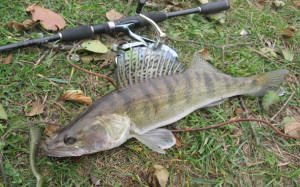
Autumn jig fishing for pike perch, with a decrease in water temperature, becomes less effective, and in November it almost completely stops.
A feature of jig fishing at this time is the migration of zander flocks across the reservoir, so stationary waiting for a bite in one place will not bring the desired result. Often, you have to change the place, or use a boat to move around the reservoir in search of the sites of this fish.
Winter fishing for pike perch on a jig is possible only in warm winters. when the surface of the reservoir is not covered with an ice shell.
At this time, it is possible to catch a fanged predator only in very deep pits. The wiring of the jig head in winter should be carried out at a very slow pace, and the pauses between windings of the fishing line must be done much longer than when catching pike perch in the warm season.
At night
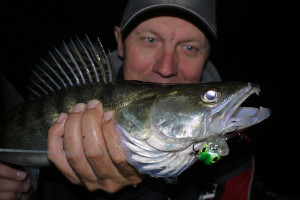
Night jig fishing is successful in the warm season, pike perch bites are especially frequent immediately after dark, and half an hour before dawn. Choosing a place for night fishing for zander should be late in the evening. At this time, you should walk along the shore of the reservoir and make several casts of the jig head. The wiring should be as aggressive as possible.
If there are bites, then you can stay in this place for night fishing for zander. Night fishing of predatory fish is often successful for those fishermen who pursue the goal of owning trophy zander.
- When fishing on a jig, you can use a sinker "cheburashka" with a hook attached to it. The size of the hook depends on the size of the fish that you plan to catch in this reservoir. Hooks are better to use a non-hooking design, because in the bottom layer of water there may be various objects for which you can hook the hook.
- When catching pike perch on a jig it is better to use special edible rubber, which better attracts a predator.
- Silicone lures it is also worth choosing with a smell that also attracts zander.

